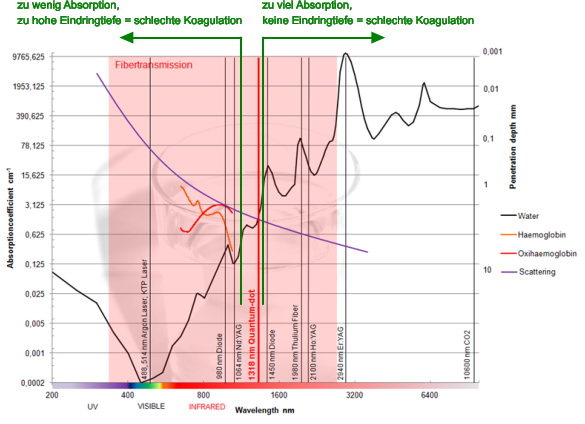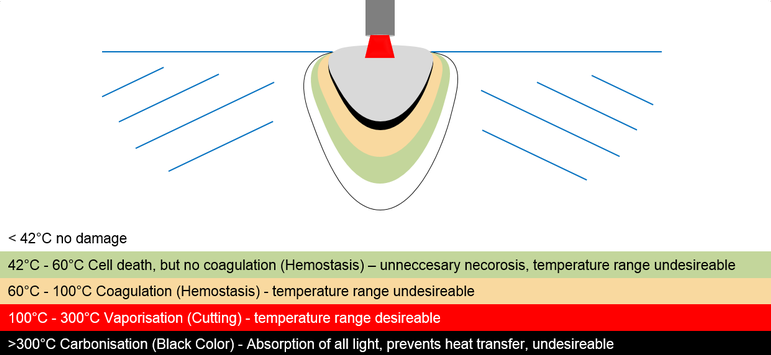basics - Rolle + Rolle
Hauptmenü:
basics
products > eraser surgical laser
Why a laser and why 1318 nm in wave length?
Lasers are sources of light with very special properties, whose practical combination enables medical applications that outperform other instruments which are based on purely mechanical or electromagnetic effect principles. The radiation created by lasers is coherent, i.e. all waive trains are in precise phase with one another in terms of time and space and it is strongly collimated, which means that the ray bundles are arranged nearly in parallel, making their diameter also increase only minimally over a large distance. Due to these two properties, bundles, highly energetic radiation can be created, which can be pointed directly at the target tissue or transferred via fibre or mirroring alarm systems in endoscopy (stomach and intestines, bladder, bronchia, neck, nose and ears, etc.) or microscopes.
As equally important as the two qualities described is the third property, the monochromasy, i.e. all wave trains have the same wave length, frequency and energy. For the medical application practice, this property is of huge significance, as this opens up the opportunity to select a very specific wave length and to merely use the interaction with a target tissue that is highly specific for it. For the effects achieved on the target tissue, the output densities and the impact time are in turn largely responsible. Due to the large variation range of output densities and impact time, very different tissue effects can be achieved that range from low-energy biostimulation through to high-energy photodisruption in kidney stone destruction for instance.
For surgical laser applications, the photothermal laser effects with output densities of 1 to 100 kW/cm² are of particularly great interest, as in permanent shift operation (continuous radiation) the simultaneous transection, coagulation and welding or sealing of highly differentiated tissue (liver, lungs, kidneys, etc.) can be expected from different temperature levels.
For the surgical practice, it is therefore necessary to generate laser radiation with output densities that can create in the centre of the radiated tissue temperatures from 100° to 300° Celsius, which result in an explosion-like vaporisation of the tissue and thereby form the section crater. On the basis of tissue-specific heat conducting, in parallel, lateral penetration penetration into the tissue cools down the temperatures within a matter of seconds from 100° to approx. 40°. Below these temperatures, tissue rich in vessels of so-called parenchymatose organs, such as the liver, lungs, spleen kidneys and the prostate, shrinks and coagulates. These organs are to be looked at in greater detail below.
If the histomorphology of these organs is taken into account, the tissue section affected by these temperatures and therefore also the penetration depth of the laser ray should be 2 mm to 4 mm inasmuch possible so that the blood, lymphoid and gall vessels shbould be affected by the shrinking process and safely coagulated. As already explained, the selection of a certain laser wave length for the tissue effects required as mandatory in the surgical application are of essential significance, as the interaction with the target tissue is exclusively wave length dependent. Responsible for the interaction of a tissue with a special laser wave length are the individual tissue components (proteins, haemoglobin, water content) and their percentage volume share. Parenchumatose organs, such as the lung, liver, kidneys and prostate, have very unified values for the protein and haemoglobin content, the average water content of 80% is also high. Only the tissue density fluctuates considerably, whereas the lungs have oly 1/5 of the density of liver tissue due to the air content of the alveoles.
As the high water content of these organs is the key tissue component, a laser wave length needs to be chosen that has a balanced distribution ratio between absorption and scattering of water. The absorption ensures the cutting qualities of the laser and the scattering for the penetration depth or the temperature spread mentioned above per penetration depth. If the absorption outweighs particularly stronglty (CO2 laser), we have a so-called cutting laser. Due to the high absorption, the energy input vapourises the tissue immediately ands the penetration depth is reduced considerably. The consequence is that the coagulation nearly disappears. If, however, the scattering outweighs (Nd:Yag laser 1064 nm), the penetration depth becomes too big. As such, the energy input is spread across a large volume with the result that both the cutting performance reduces strongly, but also the coagulation is reduced.
On the basis of animal experiment examinations, ROLLE was able to show that only the 1318 nm wave length has the desired ratio between absorption and scattering in water. The absorption is clearly above that of the Nd:YAG laser at 1064 nm in wave length, but also above the newer diode laser with wave lengths of between 800 nm and 980 nm. Furthermore, it continues to remain below the absorption of CO2, holmium, thulium and 1470 mm diode lasers, which therefore display a better cutting performance but do not achieve sufficient coagulation for the above organs.
ROLLE ET AL. was able to prove in more than 1,000 cases the clinical benefits of the 1318 nm of laser metastasis resections.
Literature:
Boulois, J-L: Photophysical Processes in Recent Medical Laser Developments: a Review. Lasers in Medical Science 1986; Vol 1 48-66.
Ott V, Bruch H-P:Evaluation der Dissektionseigenschaften eines cw Thulium-YAG Lasersystems für den Einsatz in der laparoskopischen Kolonresektion. Universität Lübeck 2005: Dissertation.
Rolle A, Pereszlenyi A, Koch R, Bis B, Baier B: Laser resection technique and results of multiple metastasectomies using a new 1318 nm Nd:YAG laser system. Lasers in Surgery and Medicine 2006; 28:26-32 (2006).
Rolle A, Pereszlenyi A: Laser resection of lung metastasis. Mutlimedia Manual of Cardiothoracic Surgery 2004; doi:10.1510/mmcts.2004.000570.
Rolle A, Unsöld E, Ruprecht L, Permanetter W, Frank F: Morphologic aspects of Nd:YAG laser application (wavelengths 1064 nm and 1318 nm) on lung tissue. Laser Med Surg 1988;4:10-14.
| Comparision of tissue impact of different instruments | ||
 |  |  |
| Section of a lung with an electric scalpel. Strong bleeding, air release. | Section of a lung with a 1064 nm Nd:YAG laser. No coagulation, air release. | Section of a lung with the 1318 nm diode laser. Broad coagulation, no air release. Due to the special wave length, a broad and safe coagulation seam is created. Bleeding is securely prevented and any air release is avoided. |
Absorption, scattering and penetration of medical lasers in water and hemoglobin | ||
 | ||
For a safe application within the framework of parenchyma surgery (lungs, kidneys, prostate), a laser must have a wave length that enables a considerable coagulation zone with a simultaneously good cutting performance. Ideally, the laser light should be conductible through flexible quartz fibres (area highlighted in red, in order to also use the laser for minimally invasive forms of treatment. For that reason, the long-wave infrared range cannot be used (CO2, Er:YAG laser). The adjoining area with the holmium, thulium and 1470 nm lasers is not optimal for the parenchyma surgery, as too high an absorption requires too low a penetration depth, therefore creating less coagulation. In the middle of the chart, the values of the absorption and scattering are optimised to a wavelength range of between 1310 nm and 1330 nm. A well-developed coagulation zone is created that effectively prevents bleeding. Accordingly, the central wave length of our patented eraser laser system also lies here. Left from the optimum, the absorption falls dramatically. Lasers in this wave length range are the 1064 nm Nd:YAG laser and the new 940-980 nm diode laser. The problem of these lasers is the high penetration depth into the tissue due to the low absorption in water. Accordingly, there is a risk of structures lower in the tissue being damaged by accident (e.g. nerves in the event of prostate surgery). This risk is even more strongly accentuated with lasers in the visible range (green light lasers), as the absorption is even lower here. |
Thermal effects of laser light on tissue | ||
| The chart indicates the temperature zones that can occur when firing laser light on tissue. The occurrence and character of the individual temperature zones vary depending on the wave length used. The wave length is therefore the crucial influencing factor for the laser. For a surgical application, the wave length needs to be chosen in such a way that the temperature ranges requires for the blood coagulation and cutting (60 - 300°C) exist in as accentuated a manner as possible, whereas the temperature zones above and below should exist at all inasmuch possible, as they have only negative effects feor the treatment (< 60°C cell death without coagulation = unnecessary necrosis formation, > 300°C blackening of the tissue = no differentiation of the tissue possible any more). |